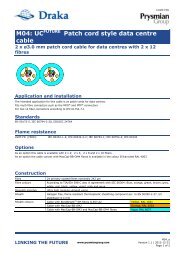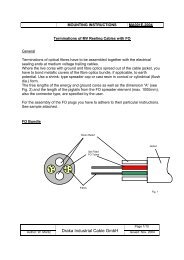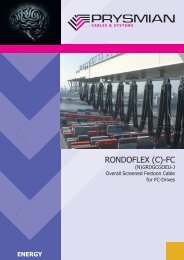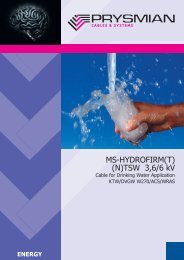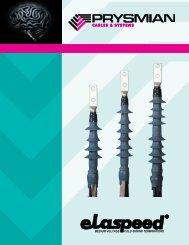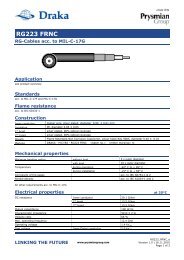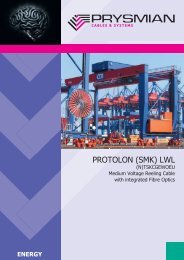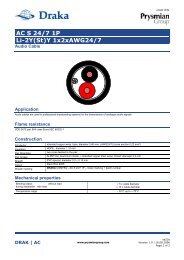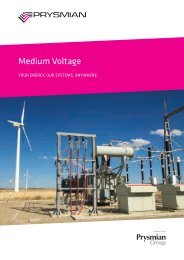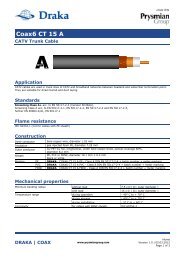Tables / Explanations AWG-Sizes - Prysmian Group
Tables / Explanations AWG-Sizes - Prysmian Group
Tables / Explanations AWG-Sizes - Prysmian Group
Create successful ePaper yourself
Turn your PDF publications into a flip-book with our unique Google optimized e-Paper software.
ShieldThe shield is a „protection“ against electromagneticfields and protects electric signals against externalsignals. The aim is to weaken or stop unwantedsignals to such an extent that the wanted datasignals can be transmitted without interference inthe endangered signalling conductor. There are threebasic types of shield structure:>>Overall shield over several coresShielded pairsIndividually shielded cores.>The overall shield over several cores, usually placedbetween the inner and outer sheaths, necessitatesuse of a special design for flexible electric cables forcranes and material handling equipment in order toprevent destruction of the shield by tensile forcesand compressive pressures occurring with frequentmovement. This has been taken into account indesign of CORDAFLEX(K) overall srceened flexiblecables for festoon systems.Shielded pairs and individually shielded cores, on theother hand, have proven themselves in practice andare successfully used in CORDAFLEX, PLANOFLEX,SPREADERFLEX and lift control cables.Braided screens are characterized by their transferimpedance which is defined as the ratio of thevoltage drop along the shield on the interferedside to the parasitic current on the other side. Thetransfer impedance R K (DIN 40500) is given for aspecific frequency in mΩ/m and is usually plottedwith respect to frequency. The lower the transferimpedance of a shield, the better the screeningeffect. The transfer impedance of the braided screensusually used for flexible electric cables for cranesand material handling equipment is optimized at 30MHz and is therefore fo-cussed on data-processingquality.A typical transfer impedance characteristic is shownin the diagram in Fig. 4/7. Field controlThe cores of PROTOLON H.V. reeling cables ofvoltage level 3 kV and above are always equippedwith inner and outer semiconductive layers made ofsemiconductive rubber.The inner and outer semiconductive layers areextruded with the insulation in a single-passoperation. Secure bonding to the insulation isobtained as a result of this method of extrusion.The inner semiconductive layer prevents build-up ofexcessive electrical field strength at the individualwires of the flexible conductor and partial dischargesbetween the conductor and the insulation.The outer semiconductive layer serves as a coreshield and performs the following tasks:>>>Protection against electric shockAvoidance of partial discharges in the conductorassemblyGeneration of the radial electrical field in theinsulationDischarge of current in the event of a fault.>The core shield is thus an integral component of theprotective-earth conductor.The resistance between the protective-earthconductor and anypoint on the outer semiconductive layer must notexceed 500 Ω. The protective-earth conductor,which touches the core shield, is covered withsemiconductive rubber and ensures longitudinalconductivity of the system. Fig. 4/8 shows the crosssectionof a PROTOLON H.V. reeling cable with innerand outer semiconductive layers.In addition to the electrical requirements, the coreshield in flexible electric cables for cranes andmaterial handling equipment must also be able tocope with the high (sometimes very high) mechanicalstresses.Metal shields are more liable to become defectivewhen used in flexible electric cables for cranes andmaterial handling equipment and are inferior toshields made of semiconductive rubber material.




